Our guide to identifying commonly used plates and screws
Debbie Howe
Senior Surgical Nurse
When it comes to plating bones, the possibilities can seem endless! This guide is aimed at giving an overview of the commonly used plates for fixing long bone fractures.
Conventional plating
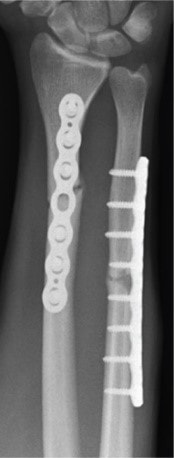 As the screw is inserted into the bone, it pulls the plate down onto the bone
As the screw is inserted into the bone, it pulls the plate down onto the bone- The developing frictional force between the plate and the bone gives the plate a stable fixation
- To ensure stability throughout the healing process, this frictional force must be maintained and able to overcome axial load forces from the patient moving around
- Blood supply to the bone can be compromised from the compression between plate and bone, leading to a degree of osteoporosis, risking delayed healing or non-union
- Good results are seen with good quality bone in any fracture that would traditionally be fixed with a lag screw
- Plate can be used with a pin in comminuted fractures
DCP- dynamic compression plates
-
Plates used for fracture fixation using conventional techniques have the additional option of applying some compression of the fracture too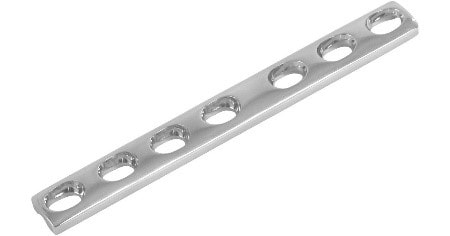
- Screws are placed in either a neutral or load position
- Have quite a large area of compression under the plate could interfere with blood supply to the bone
- This relies on friction between plate and bone for fracture healing
LC-DCP- limited contact- dynamic compression plate
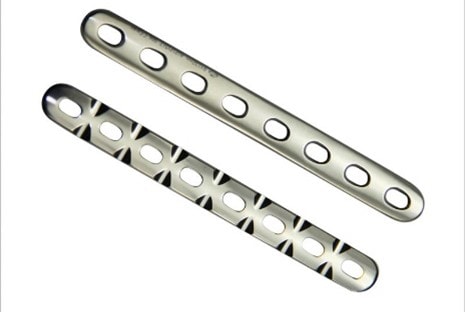 Plates used for fracture fixation using conventional techniques with the additional option of applying some compression of the fracture too
Plates used for fracture fixation using conventional techniques with the additional option of applying some compression of the fracture too- Screws are placed in either a neutral or load position
- Have a much smaller area of compression under the plate than with the DCP plate, is shown to reduce the risk of interference of blood supply to the bone
- These plates are easier to contour to the bone than DCP
- They rely on friction between the plate and bone for fracture healing
- They look similar to DCP plate but has more indentations on the underside of the plate.
Loss of reduction
Primary loss - If the plate is not precisely contoured to the bone maximum stability is not achieved and the fracture fragments may move.
Secondary loss - If the axial load is more than the frictional force achieved during fixation of the plate to the bone the fracture fragments may move.
Some fracture types will increase the risk of primary of secondary loss of reduction and may need a different approach to their fixation, such as fractures with multiple fragments, etc. Also having poor quality bone will also increase the risk of delayed healing when the DCP or LC-DCP plate contact with the bone causes an osteoporosis.
LCP- locking compression plate
- T
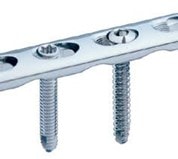 hese plates are for the fixation of fractures when adequate bone contouring is not achievable or there is poor quality bone present
hese plates are for the fixation of fractures when adequate bone contouring is not achievable or there is poor quality bone present - It produces a fixed-angle construct whereby the bone fragments are secured in position by the screw head locking into the plate
- It reduces the need for plate contouring
- Screw stability is achieved through the fixed-angle construct at the screw head and near bone cortex, in the LCP plate
- It reduces the need to have perfect plate conformation, especially where multiple fragments don’t allow for a perfect reduction
- These are ideal for fractures with multiple fragments and when minimally invasive approaches are used
- They can be used with both non-locking cortical screws and locking screws
Hole placement
 DCP/LC-DCP
DCP/LC-DCP
- The holes are set out along the plate in a line, broad plates may have the holes staggered
- Some companies make plates with have unidirectional holes for compression of the bone towards the fracture line. The midsection of the plate overlies the fracture
 Other companies make plates with symmetrical holes whereby compression can be achieved in either direction along the plate, increasing the versatility of the plate
Other companies make plates with symmetrical holes whereby compression can be achieved in either direction along the plate, increasing the versatility of the plate
LCP
-
The holes are set out in a line along the plate
- They look like a footprint shape with a neutral/load section at one end and a locking section at the other end
- Some companies make ‘stacked’ plates whereby the neutral/load section overlies the locking portion of the hole
- Stacked plate holes reduce the angulation achieved with cortical screw placement
Screws
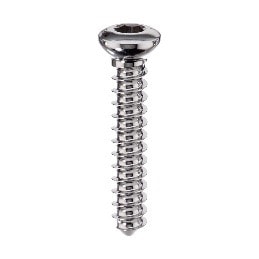 Cortical screws
Cortical screws
- This is the normal type of screw that you would imagine
- It engages with cortical bone of the far and near cortices and pulls the plate down onto the bone
- It can be used alone as lag screws, position screws or in combination with a plate
- Engagement of both near and far cortices shares the load bearing and stability at these two points on the screw
Placed in the load position
- When drilling the hole for the screw to go into, the ‘load’ position, the hole should be up against the edge of the plate hole
-
Special drill guides are available to help achieve this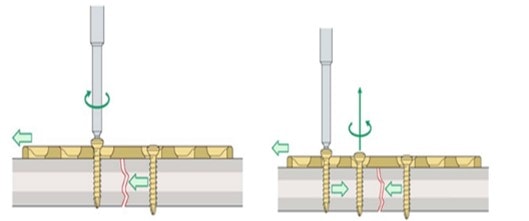
- As the screw is screwed into the bone the head of the screw pushes the plate relative to the bone
- When this is done either side of the fracture line the two fragments are pushed together to provide compression
Placed in the neutral position
 When drilling the hole for the screw to go into the ‘neutral’ position, the drill hole is positioned in the middle of the plate hole
When drilling the hole for the screw to go into the ‘neutral’ position, the drill hole is positioned in the middle of the plate hole- Special drill guides will help with this placement as they are spring loaded and when they are pressed into the plate hole, as they compress down they are guided into the middle section of the plate hole
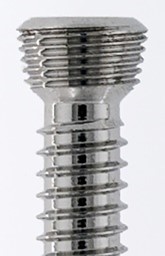 Locking screw
Locking screw
- Similar in looks to the cortical screw, on these screws in most cases the thread goes right up the head of the screw
- This allows the screw to lock into the plate
- It makes up the fixed-angle construct of the LCP plate
- Once locked in the plate, the screw cannot be further tightened and the bone is fixed where the screw has engaged and cannot be pulled up to the plate
- These allows for little or no plate contact on the bone surface, ensuring little or no compromise to bone blood supply
- They have a larger core diameter that the cortical screw to resist shearing and bending forces exerted upon it
- They have a shallow thread profile compared to the cortical screw as less emphasis is need on developing friction between plate and bone for stability
- You can have unicortical placement in the bone as stability is achieved through the locking head in the plate and purchase in the near cortex
Lag screw
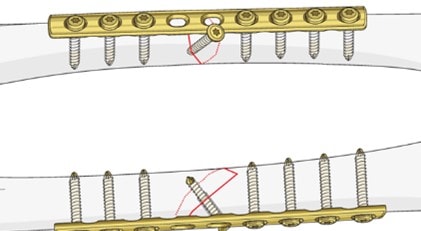 A screw, usually cortical, placed across a fracture, perpendicular to the fracture line, produces compression across the fracture
A screw, usually cortical, placed across a fracture, perpendicular to the fracture line, produces compression across the fracture- This is important when good reduction of the fracture is needed
- They can be placed separately from the plate or in conjunction with the plate
Different types of plate placement
Compression
This brings the fracture ends/fragments together with some pressure to aid quicker healing- the bone does not need to fill a gap first before healing together.
Bridging
This uses the plate as an extra-medullary splint- reducing the need to move the fracture fragments which could disrupt the blood supply.
Neutralisation
Neutralisation plates are used in a fracture that can be reconstructed, for example with lag screws. The plate is then applied and the loading forces are able to be shared between the plate and the bone.
But remember, all of these techniques can be achieved using the same plate. It just has the screws placed slightly differently!!!



